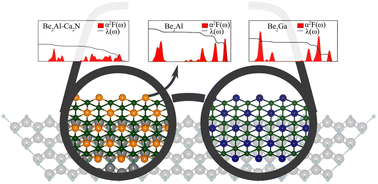Two-dimensional Be2Al and Be2Ga monolayer: anti-van’t Hoff/Le Bel planar hexacoordinate bonding and superconductivity†
Abstract
Because of the electron deficiency of boron, a triangular network with planar hexacoordination is the most common structural and bonding property for isolated boron clusters and two-dimensional (2D) boron sheets. However, this network is a rule-breaking structure and bonding case for all other main-group elements. Herein, the Be2M (M = Al and Ga) 2D monolayer with P6/mmm space group was found to be the lowest-energy structure with planar hexacoordinate Be/Al/Ga motifs. More interestingly, Be2Al and Be2Ga were observed to be intrinsic phonon-mediated superconductors with a superconducting critical temperature (Tc) of 5.9 and 3.6 K, respectively, where compressive strain could further enhance their Tc. The high thermochemical and kinetic stability of Be2M make a promising candidate for experimental realization, considering its high cohesive energy, absence of soft phonon modes, and good resistance to high temperature. Moreover, the feasibility of directly growing Be2M on the electride Ca2N substrate was further demonstrated, where its intriguing electronic and superconducting properties were well maintained in comparison with the freestanding monolayer. The Be2M monolayer with rule-breaking planar hexacoordinate motifs firmly pushes the ultimate connection of the “anti-van’t Hoff/Le Bel” structure with promising physical properties.



 Please wait while we load your content...
Please wait while we load your content...